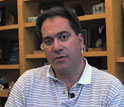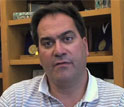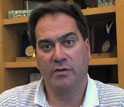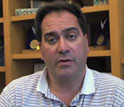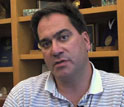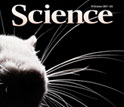News Release 11-218
Nano Materials by Design: No Small Breakthrough
Design rules will enable scientists to build desired nanomaterials for broad application of nanotechnology to address social challenges, bolstering industry and creating jobs

Gold nanoparticles are assembled with DNA linkers into crystalline lattices.
October 13, 2011
View video soundbites (video1, video2, video3, video4, video5) with Northwestern University Professor Chad Mirkin.
This material is available primarily for archival purposes. Telephone numbers or other contact information may be out of date; please see current contact information at media contacts.
Learning the rules for consistently arranging nanoparticles, like nature arranges atoms into molecules and materials, has been a goal of scientists for quite some time because doing so is essential to capitalize on nanotechnology's potential for broad application. This challenge has now been met for a class of materials.
The discovery is detailed in the Oct. 14, 2011 issue of the journal Science and in news released by Northwestern University today. The National Science Foundation (NSF) funds the research.
Specifically, lead author Chad Mirkin of Northwestern University and his team developed rules that enable scientists to make any structure for almost any application.
"This discovery is the largely the result of high-risk, high reward funding of basic research, in NSF's Nanoscale Science and Engineering Centers" said Mihail C. Roco, senior advisor for nanotechnology at NSF, key architect of the National Nanotechnology Initiative and founding chair of the U.S. National Science and Technology Council's Subcommittee on Nanoscale Science, Engineering and Technology.
Roco continued, "In our 2003 National Nanotechnology Initiative report, we identified the efficient creation of nanomaterials with prescribed properties and functions as key to broad applicability of nanotechnology. With this discovery, Mirkin and his team have met that challenge for a large set of materials. The future is indeed bright for revolutionary new materials and systems and what they will bring to our daily life and to our economic livelihood--from innovative disease treatments, new information methods and more efficient energy conversion storage and use to the companies and jobs created in the process."
Watch and listen to Chad Mirkin as he discusses his discovery and its broad implications for the future of science.
Chad Mirkin is the George B. Rathmann Professor of Chemistry in the Weinberg College of Arts and Sciences and professor of medicine, chemical and biological engineering, biomedical engineering and materials science and engineering at Northwestern University and director of its International Institute for Nanotechnology. He also sits on the President's Council of Advisors on Science and Technology.
-NSF-
-
View Video
Mirkin describes the importance of what was discovered.
Credit and Larger Version -
View Video
Mirkin predicts what is now possible with these new design rules.
Credit and Larger Version -
View Video
Mirkin puts nanotechnology in a context of U.S. strategic goals and priorities.
Credit and Larger Version -
View Video
What's next for nanotechnology? Mirkin offers his forecast.
Credit and Larger Version -
View Video
Mirkin shares his views on the importance of a U.S. investment in basic research.
Credit and Larger Version -
The researchers' work is described in the October 14, 2011 issue of the journal Science.
Credit and Larger Version
Media Contacts
Lisa-Joy Zgorski, NSF, (703) 292-8311, email: lisajoy@nsf.gov
Megan Fellman, Northwestern University, (847) 491-3115, email: fellman@northwestern.edu
Program Contacts
Mihail C. Roco, NSF, (703) 292-7032, email: mroco@nsf.gov
Principal Investigators
Chad Mirkin, Northwestern University, (847) 491-2907, email: chadnano@northwestern.edu
Related Websites
NSF National Nanotechnology Initiative (NNI): http://www.nsf.gov/crssprgm/nano/
PCAST Report on the Third Assessment of the National Nanotechnology Initiative: http://go.usa.gov/9NS
The U.S. National Science Foundation propels the nation forward by advancing fundamental research in all fields of science and engineering. NSF supports research and people by providing facilities, instruments and funding to support their ingenuity and sustain the U.S. as a global leader in research and innovation. With a fiscal year 2023 budget of $9.5 billion, NSF funds reach all 50 states through grants to nearly 2,000 colleges, universities and institutions. Each year, NSF receives more than 40,000 competitive proposals and makes about 11,000 new awards. Those awards include support for cooperative research with industry, Arctic and Antarctic research and operations, and U.S. participation in international scientific efforts.
Connect with us online
NSF website: nsf.gov
NSF News: nsf.gov/news
For News Media: nsf.gov/news/newsroom
Statistics: nsf.gov/statistics/
Awards database: nsf.gov/awardsearch/
Follow us on social
Twitter: twitter.com/NSF
Facebook: facebook.com/US.NSF
Instagram: instagram.com/nsfgov



